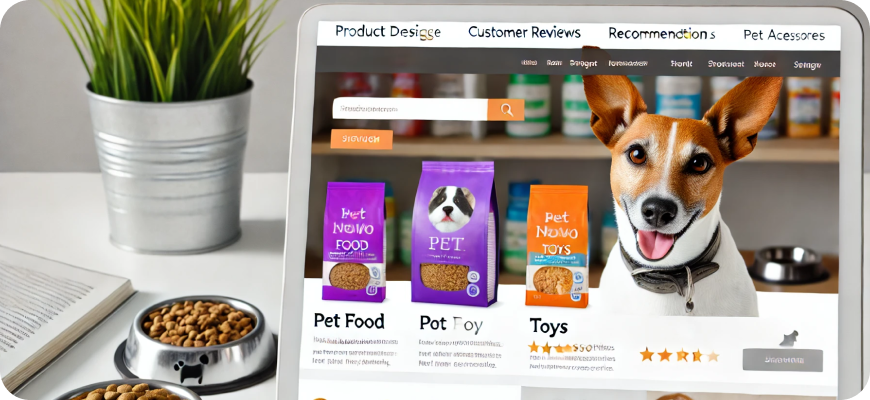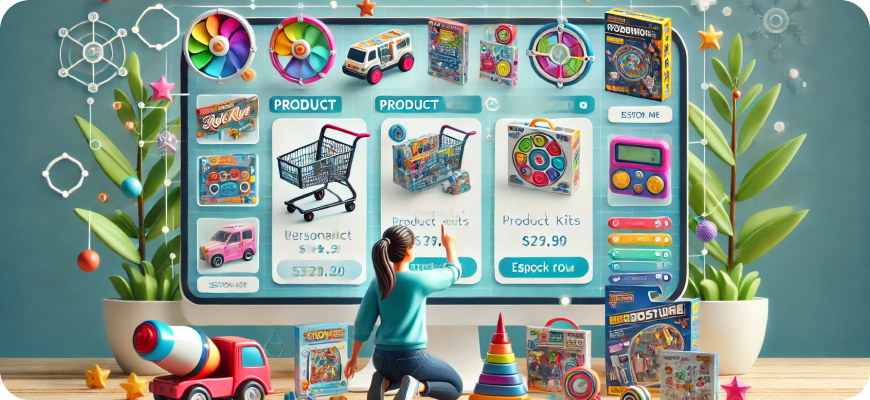Ecommerce Best Practices for Pets & Animals
The pet and animal e-commerce market is thriving, driven by pet parents who are willing to spend on food, toys, accessories, health products, and services for their beloved companions. This dynamic sector requires businesses to focus on trust, convenience, and personalized experiences to meet the diverse needs of pet owners and their furry, feathered, or scaled friends. By implementing the right e-commerce strategies, brands can attract loyal customers, offer excellent service, and ensure repeat purchases.
Here is a comprehensive guide to e-commerce best practices for the pets and animals industry.

1. Prioritize High-Quality Visual Content
Pet owners want to ensure they are buying quality products for their companions. Visual content plays a key role in building trust and engaging customers:
- High-Resolution Images: Provide multiple images that showcase the product from various angles. Show close-ups of important features such as ingredients, textures, or materials.
- Lifestyle Photos: Include images of pets using the products in real-life scenarios. For example, dogs playing with toys, cats using scratch posts, or birds enjoying their treats.
- Product Videos: Create engaging videos demonstrating product features, how-tos, or testimonials from pet owners and their pets.
2. Offer Detailed Product Descriptions and Ingredient Transparency
Pet parents are often cautious about what they buy for their animals, especially when it comes to food and health products:
- Ingredient Lists: Clearly list all ingredients for pet food and treats, highlighting any special attributes such as organic, grain-free, or hypoallergenic.
- Nutritional Information: Provide nutritional breakdowns and health benefits for food items.
- Product Specifications: Offer detailed descriptions of dimensions, materials, usage instructions, and care tips for accessories and toys.
3. Leverage Personalization and Product Recommendations
Personalization helps pet owners find the right products for their specific needs:
- AI-Driven Recommendations: Use AI to analyze customer behavior, pet profiles, and past purchases to recommend products tailored to their needs.
- Customizable Pet Profiles: Allow customers to create profiles for their pets, including species, breed, age, dietary restrictions, and preferences. Use this information to personalize recommendations.
- Custom Bundles: Offer personalized product bundles, such as a monthly subscription box tailored to a pet’s size, preferences, or health needs.
4. Optimize for Mobile Shopping
Many pet owners prefer to shop on their mobile devices for convenience:
- Responsive Mobile Design: Ensure your website is optimized for mobile devices, with an intuitive layout, fast loading times, and touch-friendly buttons.
- Mobile Checkout Optimization: Simplify the checkout process with mobile-friendly forms, auto-fill options, and support for digital wallets like Apple Pay and Google Pay.
- Mobile Apps: Consider developing a mobile app for loyalty programs, product reordering, personalized content, and app-exclusive offers.
5. Provide Flexible Subscription Services
Subscription models work well for pet care products that need regular replenishment:
- Subscription Boxes: Offer recurring subscription boxes for pet food, treats, toys, or health products. Allow customers to customize box contents and frequency.
- Flexible Management Options: Give customers the ability to pause, skip, or modify their subscription plans with ease.
- Exclusive Subscriber Perks: Provide exclusive perks for subscribers, such as special discounts, early access to new products, or personalized gifts.
6. Focus on Building Trust and Transparency
Building trust is crucial for pet owners who prioritize safety and quality:
- Product Certifications and Testing: Highlight any certifications, such as USDA Organic, Non-GMO, or cruelty-free testing, for relevant products.
- Customer Reviews and Testimonials: Encourage customers to share their experiences through reviews, ratings, and photos. Verified reviews help build credibility.
- Ingredient Sourcing Transparency: Share information about where your ingredients come from and your commitment to quality, ethical sourcing, or sustainability.
7. Create Engaging Content and Educational Resources
Pet owners often seek advice and information before making purchases:
- Blogs and Articles: Write informative content on topics like pet care tips, training advice, or breed-specific needs. Examples include “How to Choose the Best Dog Food” or “Caring for Your Senior Cat.”
- Videos and How-To Guides: Create videos demonstrating product use, training tips, or health care advice.
- Interactive Content: Offer quizzes to help pet owners find the right products, such as “Which Cat Food is Best for Your Cat’s Age and Health?”
8. Highlight Sustainability and Eco-Friendly Practices
Sustainability is becoming increasingly important for pet owners:
- Sustainable Products: Highlight eco-friendly products, such as biodegradable poop bags, sustainably sourced pet food, or recycled-material toys.
- Eco-Friendly Packaging: Use minimal and recyclable packaging, and communicate this commitment to customers.
- Green Initiatives: Share any green initiatives, such as partnerships with animal shelters, donations to conservation projects, or recycling programs.
9. Offer Flexible Payment and Financing Options
Flexible payment options make your products more accessible:
- Multiple Payment Methods: Accept various payment methods, including credit/debit cards, digital wallets, and bank transfers.
- Buy Now, Pay Later (BNPL) Services: Partner with BNPL providers like Klarna, Afterpay, or Affirm to offer payment plans for higher-priced items such as pet furniture or specialty equipment.
- Loyalty Points Redemption: Allow customers to redeem loyalty points for discounts, making purchases more affordable.
10. Streamline the Checkout Process
A seamless checkout process can reduce cart abandonment:
- Guest Checkout Option: Allow customers to complete purchases without creating an account.
- Progress Indicators: Use progress indicators during checkout to reassure customers and reduce drop-offs.
- Auto-Fill and Security Measures: Implement auto-fill options for forms and ensure strong data protection measures.
11. Provide Exceptional Customer Support
Responsive and knowledgeable customer support enhances customer satisfaction:
- Live Chat and Chatbots: Offer 24/7 live chat support for product inquiries, order issues, and general pet care questions. Chatbots can handle common queries, while human agents manage complex issues.
- Comprehensive FAQ Section: Maintain a detailed FAQ section addressing common questions about products, shipping, returns, and pet health topics.
- Post-Purchase Follow-Ups: Send follow-up emails to ensure customer satisfaction, solicit feedback, and offer additional care tips or product recommendations.
12. Leverage Social Media for Engagement and Growth
Social media is a powerful platform for engaging with pet owners:
- Shoppable Posts: Use platforms like Instagram and Facebook to create shoppable posts, making it easy for customers to purchase directly from their feeds.
- User-Generated Content (UGC): Encourage customers to share photos and stories of their pets using your products. Feature this content on your website and social channels.
- Interactive Content: Host contests, Q&A sessions, or live streams with pet care experts to engage your audience.
13. Highlight Promotions and Seasonal Campaigns
Promotions can create excitement and drive sales:
- Holiday-Themed Sales: Create promotions around major holidays, such as National Pet Day, Christmas, or Halloween (e.g., pet costumes).
- Limited-Time Offers: Create urgency with flash sales or limited-time discounts on popular items.
- Bundle Deals: Offer discounted bundles, such as “New Puppy Starter Kit” or “Cat Treat Variety Pack.”
14. Use Data Analytics to Optimize Performance
Data-driven insights can help you improve customer experiences and business performance:
- Customer Behavior Analysis: Use analytics to track customer behavior, including browsing patterns, purchase history, and product preferences.
- A/B Testing: Conduct A/B tests on product pages, checkout flows, and promotions to identify what resonates best with your audience.
- Retention Metrics: Monitor customer retention rates, repeat purchase rates, and churn rates to identify areas for improvement.
15. Emphasize Fast and Reliable Shipping
Shipping is crucial for customer satisfaction, especially for perishable items or recurring orders:
- Multiple Shipping Options: Offer a range of shipping options, including expedited and same-day delivery for essentials like pet food.
- Real-Time Tracking: Provide customers with real-time order tracking to monitor their shipments.
- Eco-Friendly Shipping Options: Consider offering carbon-neutral shipping or using environmentally friendly packaging.
16. Build a Loyalty Program
Loyalty programs encourage repeat purchases and customer retention:
- Points-Based Rewards Program: Offer points for purchases, referrals, and reviews that can be redeemed for discounts, exclusive products, or gifts.
- Exclusive Perks for Members: Provide loyalty members with early access to sales, new product launches, or personalized offers.
- Referral Incentives: Reward customers who refer friends or family to your store with discounts or points.
17. Collaborate with Influencers and Pet Experts
Influencer collaborations and expert partnerships can increase brand credibility:
- Pet Influencer Collaborations: Partner with pet influencers who can authentically showcase your products through social media posts, reviews, or tutorials.
- Veterinarian Endorsements: Collaborate with veterinarians or pet nutritionists to create content that educates customers and builds trust.
- Workshops and Live Events: Host live events, Q&A sessions, or workshops on pet care topics.
18. Ensure Compliance and Product Safety Standards
Compliance with regulations is critical for pet health and safety:
- Product Testing and Certification: Ensure that products meet relevant safety standards and display certifications for pet health products.
- Clear Labeling: Provide clear labeling for food, treats, and health products, including ingredient lists, usage instructions, and warnings.
- Recall Procedures: Have a clear process for addressing product recalls to protect customers and build trust.
19. Highlight Customer Reviews and Success Stories
Social proof builds trust and encourages new customers to buy:
- Customer Testimonials: Feature testimonials from satisfied customers, including photos or videos of their pets using your products.
- Success Stories: Share success stories, such as health transformations or training milestones, achieved using your products.
- Review Sorting Options: Allow users to sort reviews by relevance, date, rating, or helpfulness.
20. Utilize Sustainability Initiatives and Community Engagement
Demonstrating care for the community and environment resonates with customers:
- Charitable Contributions: Partner with animal shelters or donate a portion of sales to pet-related causes.
- Community Engagement Events: Host or sponsor events such as adoption drives, pet training classes, or pet-friendly outdoor activities.
- Recycling Programs: Offer recycling initiatives for old toys, packaging, or pet gear.

Conclusion
The pets and animals e-commerce industry thrives on personalized experiences, quality products, and exceptional customer support. By focusing on building trust, engaging with customers, and offering seamless online shopping experiences, brands can create a loyal customer base and stand out in this competitive market. Following these best practices will ensure a positive shopping experience, foster customer loyalty, and lead to long-term success in the pets and animals sector.
This guide outlines essential strategies for creating memorable and engaging customer experiences, optimizing your e-commerce operations, and building trust in the pet and animal e-commerce industry.





